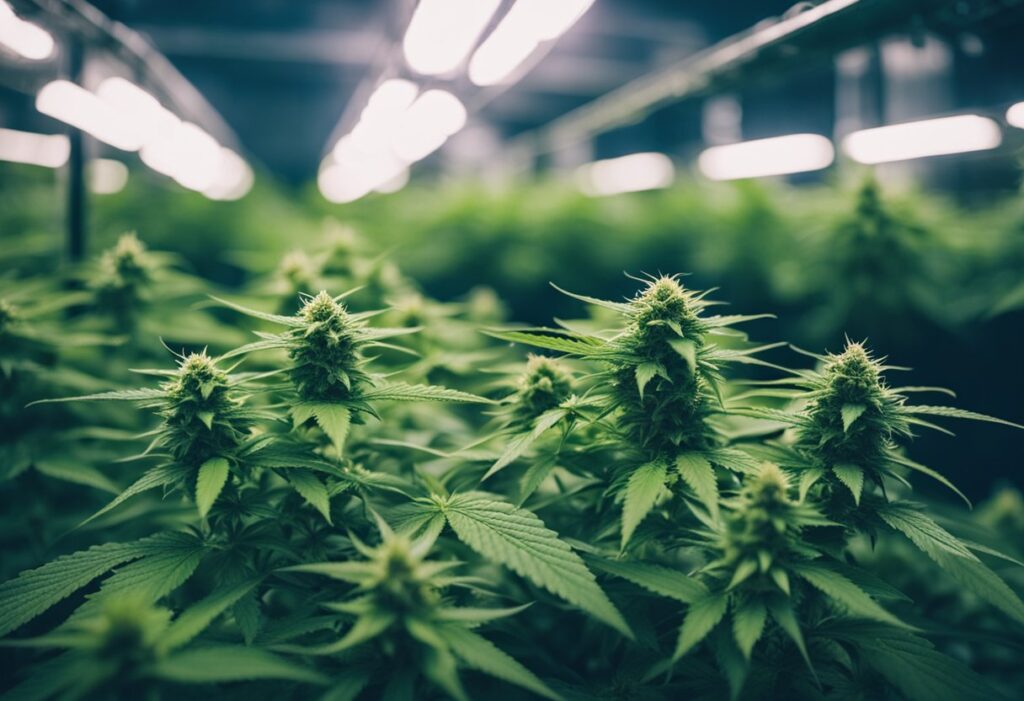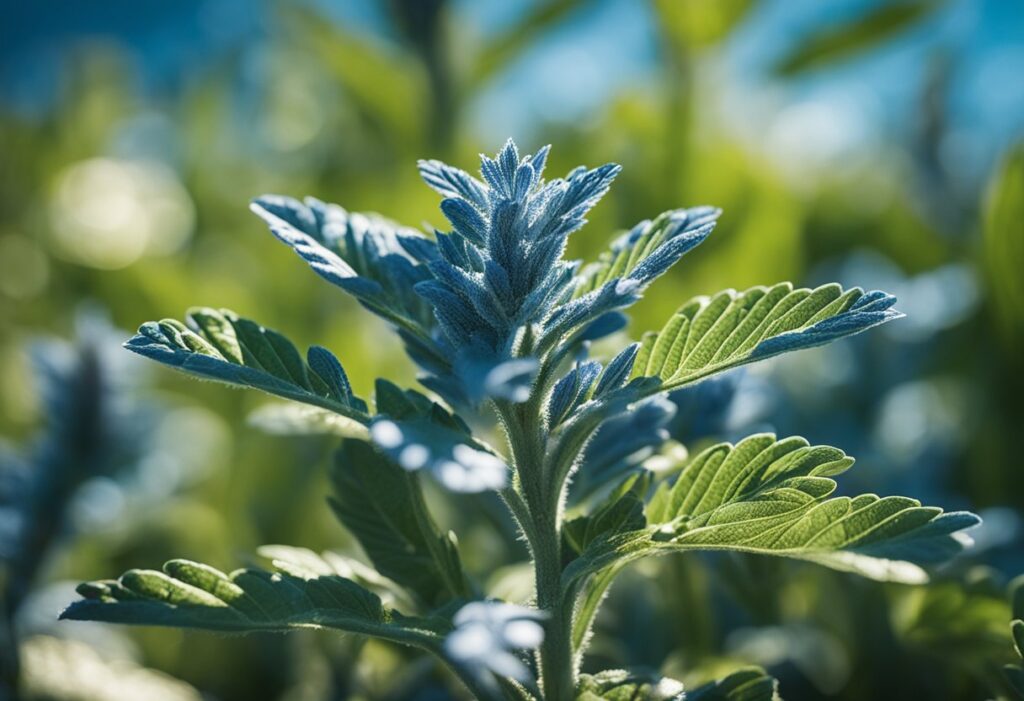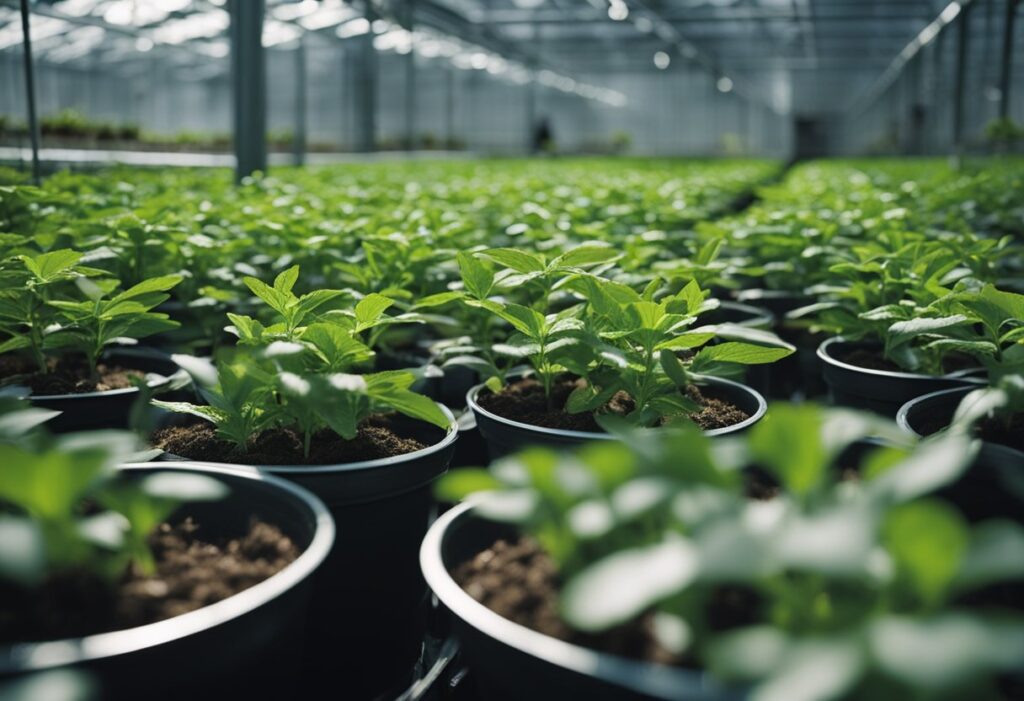
Familiarizing yourself with the genetics and characteristics of Blue Dream is essential if you aspire to successfully cultivate this strain. This section will guide you through its Californian origins, sativa-dominant nature, and distinctive features.
Blue Dream has its roots in the rich Californian cannabis culture, setting a high standard for quality. As a grower in Canada, you have the opportunity to tap into this legacy. The strain balances a complex terpene profile and high THC content, owing to its Golden State lineage.
A harmonious blend defines Blue Dream—it’s predominantly sativa but carries a significant indica influence. This hybrid marries the Blueberry strain for its indica properties with the Super Silver Haze, adding a spirited sativa touch. Expect a robust plant with the uplifting effects of its sativa lineage and the soothing impact of its indica side.
When you encounter Blue Dream, you’ll notice its distinct aroma reminiscent of sweet berries, inherited from the Blueberry parent. The flavor profile is a rich tapestry of berry notes supported by an earthy base. Its haze ancestry is apparent in the lingering spicy aftertone. Recognizable by its azure-tinted trichomes and a stature that stands tall with dense foliage, Blue Dream’s appearance is as impressive as its aromatic terpene makeup.

When growing Blue Dream seeds in Canada, you need to consider the diverse climate conditions and craft an environment that mimics the strain’s preferred Mediterranean climate, with careful attention to factors like light, temperature, and soil quality.
For outdoor cultivation of Blue Dream in Canada, timing is key to take advantage of the suitable weather during the short growing season. You should aim to plant after the last frost, typically late May to early June. Blue Dream thrives in a warm climate with a humidity level around 40%-50%. In Canada’s variable climate, monitoring and protecting your plants from early frost in fall is critical. Utilize techniques like coverings or portable greenhouses to safeguard your cannabis from unpredictable weather.
Indoor cultivation allows you to control your growing environment year-round. Your Blue Dream seeds will require a consistent light cycle of 18 hours on and 6 hours off during the vegetative stage, shifting to a 12/12 cycle during flowering. Maintain temperatures between 70-85°F (21-29°C) for optimal growth and to ensure your plants express their full genetic potential. During flowering, especially in the denser Canadian climate, lower humidity gradually to avoid mold, aiming for 30%-40%.
Blue Dream requires high-quality soil rich in nutrients. You’ll want a mix that provides excellent drainage and a slightly acidic to neutral pH level. Begin with a balanced fertilizer and adjust based on plant response. Over-watering is a common mistake; ensure soil moisture is consistent but not saturated, allowing your Blue Dream plants to develop a strong root system. Regularly test your soil to gauge when additional nutrients or adjustments are needed.

Before you dive into the process of germinating your Blue Dream seeds, it’s important to understand that the quality of your seeds directly impacts your success. Let’s begin by ensuring your seeds are primed for germination.
To maximize your chances of success with germinating Blue Dream seeds, quality is key. Start by sourcing your seeds from a reputable supplier like Farmers Lab Seeds to ensure you receive feminized seeds with a germination guarantee. Check the seeds for any signs of damage or discoloration and use only those that appear healthy and intact.
The paper towel method is a popular and reliable way to germinate your cannabis seeds. Here’s how you can use it for Blue Dream seeds:
After your Blue Dream seeds have sprouted, it’s critical to transplant them with care to ensure robust, healthy growth.
Remember to maintain gentle airflow and adequate moisture levels as your Blue Dream seedlings begin their growth journey in their new environment.

Mastering the flowering stage and harvesting of Blue Dream is pivotal for achieving high yields and potent THC content. Whether you’re growing indoor or outdoor, paying close attention to lighting, trichome maturity, and post-harvest processes ensures top-quality cannabis.
For Blue Dream, the flowering period typically lasts between 7 to 9 weeks. During this critical phase, your plants will require a precise light schedule of 12 hours of light and 12 hours of darkness to stimulate blooming. If you’re growing indoors, ensure your grow lights provide sufficient intensity and coverage to mimic outdoor conditions, optimizing your plant’s flowering potential for recreational or medicinal use. It’s recommended to increase the temperature to around 80-85 degrees Fahrenheit and decrease the humidity level by 5% weekly until it reaches 30-40%, to create an ideal environment for your Blue Dream.
The harvest time for Blue Dream is all about waiting for the right moment when THC content is at its peak. This is when the trichomes on the buds transition from clear to a milky white color. Employ a magnifying glass or jeweler’s loupe to inspect the trichomes closely. Once you observe that most trichomes have clouded over with just a few amber ones, it’s time to harvest. Harvesting at this stage will ensure a high THC level, which is essential for both recreational enjoyment and medicinal benefits, capturing the highest potency and best expression of cannabinoids.
After you’ve carefully harvested your Blue Dream, the drying and curing processes are vital to lock in flavor and potency. Start by trimming your buds and placing them on a drying rack, ensuring good air circulation and a stable environment with temperatures around 70 degrees Fahrenheit and humidity close to 50%. This initial drying phase typically takes about a week. Follow this with a thorough curing process, storing your buds in airtight containers, opening them several times a day for the first week to allow for controlled humidity release. Curing properly not only enhances the potency and therapeutic effects of your Blue Dream but also maximizes yield, as this process will preserve the cannabinoids and terpenes.

When cultivating Blue Dream cannabis in Canada, protecting your crop from pests and diseases is vital for ensuring a successful harvest. Here, we’ll cover specific tactics to defend your plants against common threats like mold and mildew, and introduce practices to control humidity and airflow, as well as various treatments to keep pests at bay.
Mold and mildew can devastate your cannabis crop by attacking the stems and leaves, potentially leading to significant yield losses. To prevent outbreaks:
The microenvironment of your cannabis plants—particularly temperature, humidity, and airflow—plays a pivotal role in disease prevention. To create an optimal growing space for your Blue Dream strain:
Pests like spider mites, aphids, and whiteflies can harm your cannabis cultivation. For pest management:
By following these outlined strategies, you can safeguard your cannabis plants from common pests and diseases, ensuring your hard work yields lush, healthy Blue Dream cannabis.
Navigating the ins and outs of cannabis cultivation can be intricate. Your success with Blue Dream seeds in Canada can depend greatly on how you water them, alongside other specific care considerations.
To ensure Blue Dream plants thrive in Canada’s diverse climate, you need to balance moisture content. Water your plants when the topsoil becomes dry to touch. During hotter months, you may need to increase the frequency, while colder periods demand less watering to prevent root rot.
Growing Blue Dream seeds indoors requires careful attention to humidity and watering schedules. Avoid overwatering to prevent mold and ensure good drainage. Small, frequent watering is typically preferable to soaking the soil, maintaining a consistent moisture level without waterlogging.
With feminized Blue Dream seeds, you want to avoid stressing the plants as they are sensitive to changes in their environment. Ensure a strict light schedule and steady watering regime, and be careful not to over-fertilize, which can lead to nutrient burn.
Blue Dream autoflowers have a shorter lifecycle, requiring a different approach than regular seeds. Provide consistent light for 18-24 hours a day and avoid transplanting to prevent stress. Water lightly but frequently, as autoflowers are prone to overwatering due to their smaller size.
During the flowering stage, reduce nitrogen intake and up the phosphorus to encourage blooming. Water your Blue Dream plants with a lower pH to enhance nutrient uptake and prepare for reduced watering as you near harvest, to promote resin production and flavor.
We ship and deliver world wide via USPS and various couriers.
We offer a wide range of secure and anonymous online payment options.
We care about you, our customer. Please contact us with any questions or concerns.
Find out more about the benefits of being a loyal and regular customer.
WE ARE EVERY GROWERS ONE STOP SHOP TO ACQUIRE PREMIUM CANNABIS SEEDS FOR SALE IN THE USA, CANADA AND AUSTRALIA

Farmers Lab Seeds 2024, | All Right Reserved
Seeds are sold as novelty items, souvenirs, and collectibles. They contain 0% THC. We encourage our customers to check the legislation in their Country, State, Province, and Municipality prior to purchasing items from our store. We do not provide growing information.
All seeds are sold as hemp, and lab tested under 0.3% THC. This product is not for use by or sale to persons under the age of 21. This product should be used only as directed on the label. It should not be used if you are pregnant or nursing. Consult with a physician before use if you have a serious medical condition or use prescription medications. A Doctor’s advice should be sought before using this and any supplemental dietary product. All trademarks and copyrights are property of their respective owners and are not affiliated with nor do they endorse this product.
These statements have not been evaluated by the FDA. This product is not intended to diagnose, treat, cure or prevent any disease. Individual weight loss results will vary. By using this site, you agree to follow the Privacy Policy and all Terms & Conditions printed on this site. Void Where Prohibited by Law.